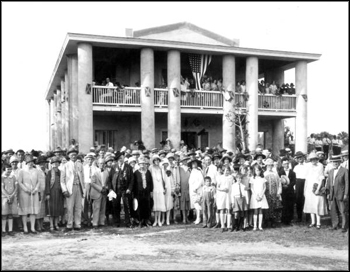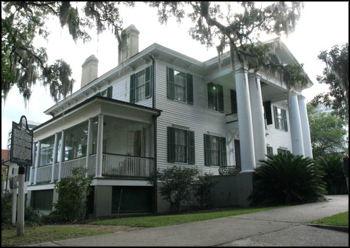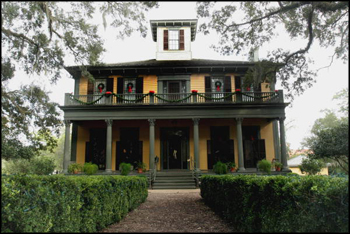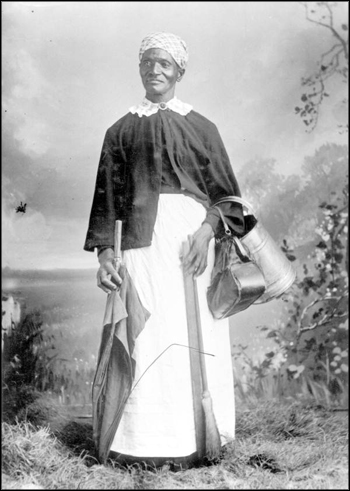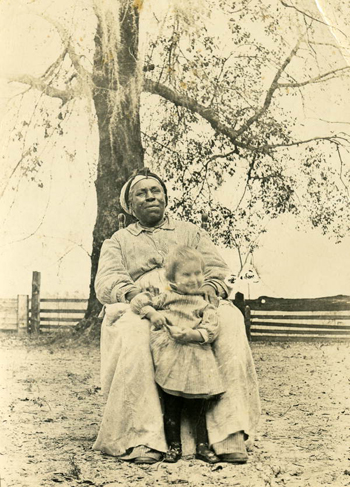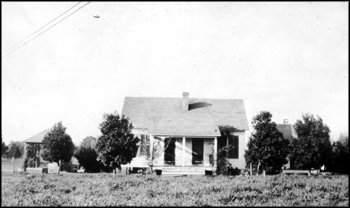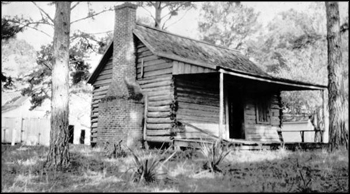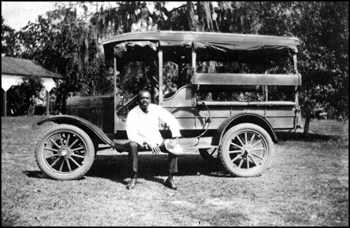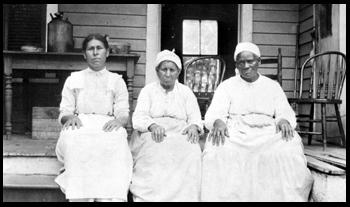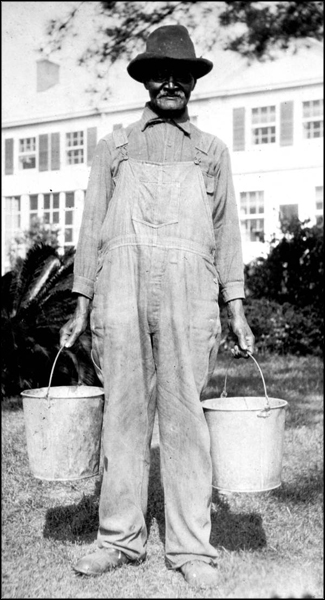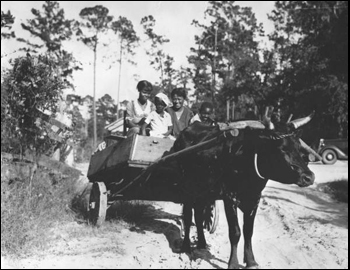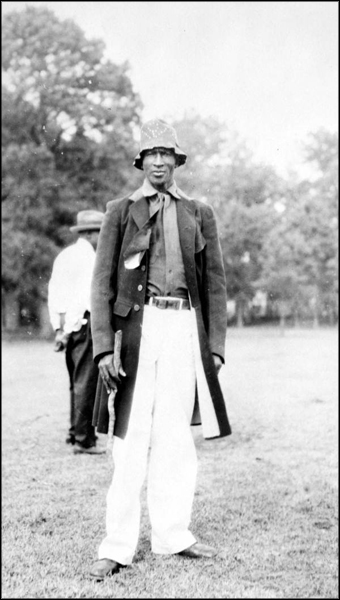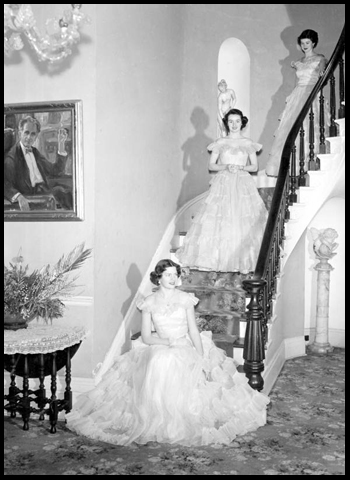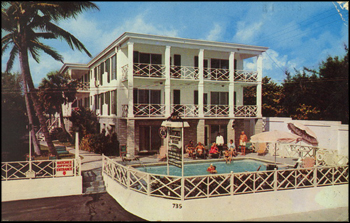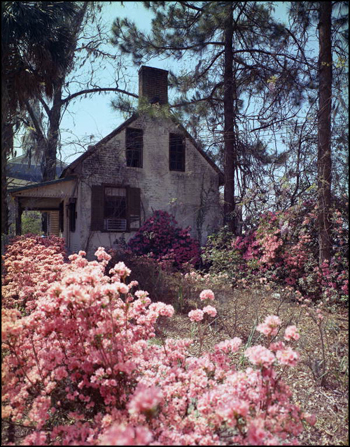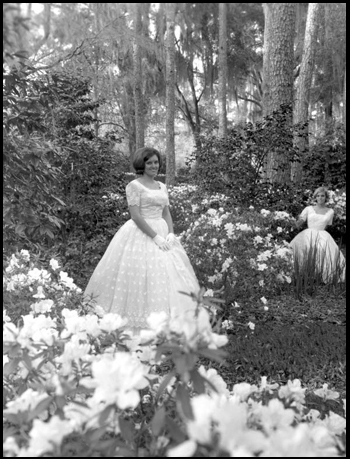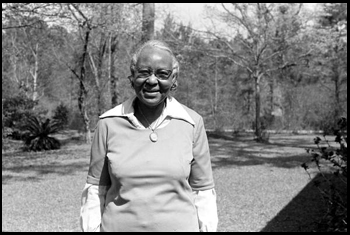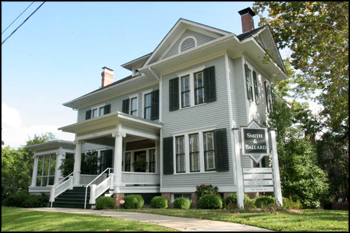Photo Exhibits
Photo exhibits spotlight various topics in Florida history, and are accompanied by brief text intended to place selected materials in historical context.
Plantation Culture
Land and Labor in Florida History
The Legacy of Plantation Culture
Few antebellum estates remain intact in 21st century Florida. Some of the grand homes that still stand serve as museums on the social, cultural and environmental history of plantation life and work in Florida history.
Confederate veterans and crowd standing at the Gamble Plantation: Ellenton, Florida (ca. 1920s)
Image Number: PR10556
Major Robert Gamble built this home in the 1840s following the end of the Second Seminole War. With the only surviving antebellum plantation in southern Florida, Gamble produced sugar and molasses for the New Orleans market. In 1925, the United Daughters of the Confederacy (UDC) acquired the home and 16 acres of property. The UDC donated the property to the State of Florida, which currently operates the Gamble Mansion as a state park.
Gregory House at Torreya State Park: Rock Bluff, Florida (ca. 1970s)
Image Number: RC20542
Knott House Museum at 301 East Park Avenue: Tallahassee, Florida (2006)
Image Number: PR20840
Free black contractor George Proctor probably built this house in 1839-42 for Katherine Gamble, bride of Thomas Holmes Hagner, U.S. minister to the court of King George IV of England. The east end of the block was taken up with formal gardens that were said to be the site of the first Japonica tree in Florida (brought from England to Mrs. Hagner's home in Virginia). Dr. George W. Betton bought the property in 1880 and altered it in 1885. Later it was the home of the Carters, Shacklefords, and the Knotts, who altered the front in 1928. The Florida Department of State now operates the house as a museum.
Brokaw-McDougall House at 329 Meridian Street: Tallahassee, Florida (2006)
Image Number: PR30135
Built in the early 1850s for Perez B. Brokaw. Later the home of Mrs. Alex McDougall, daughter of the original owner. The Florida Department of State owns the Brokaw-McDougall House.
Social Change and Large Estates
The role of large estates as producers of agricultural products decreased significantly following the 19th century. Commercial farming replaced many of the family operations that persisted following the Civil War.
Most plantations reverted to less intensive uses of the land after 1865. Recreational use replaced agriculture as the primary function of large estates. New owners converted the land into hunting plantations and replicated much of the lifestyle enjoyed by their predecessors, including dependence on a largely African-American labor force.
Former slaves became sharecroppers and domestic workers on large estates. In the 20th century, many African-Americans left the South for employment opportunities in northern states. So great was the exodus of African-Americans from the South between 1914 and 1945, this movement of people is called the Great Migration by historians.
Aunt Memory Adams: Tallahassee, Florida (ca. 1900)
Image Number: RC00722
Aunt Memory Adams was born into slavery. When she was 24 years old she was taken to Tallahassee and sold to Mr. Argyle for $800. Aunt Memory attended the 1893 World's Fair, and sold enough photos of herself to pay for expenses.
Susie Scruggs with "Aunt Pink": Leon County, Florida (1913 or 1914)
Image Number: PR77780
Susie Scruggs later became Mrs. Richard Bradford. Photographed at the Cason/Bunker Plantation Little Egypt in eastern Leon County.
House for servants at Welaunee Plantation: Leon County, Florida (ca. 1923)
Image Number: RC07241
Employee cabin at Killearn Plantation and Gardens: Tallahassee, Florida (1925)
Image Number: RC13490
The Killearn Plantation and Gardens (later Maclay Gardens) were planted and designed by Alfred Barmore Maclay starting in 1923. Maclay featured camellias as the backbone of the gardens design, but also included hundreds of other flowers. The name "Killearn" came from a village in Scotland where Mr. Maclay's great-grandfather, the Reverend Archibald Maclay, was born. Maclay died in 1944, and two years later his wife made the gardens public. In April 1953, Mrs. Alfred B. Maclay and her children gave the 307-acre Killearn Gardens (including the Maclay house) to the Florida Board of Parks and Historic Memorials as a memorial to Alfred Barmore Maclay. The Maclay House and most of the associated buildings were constructed circa 1906 to 1909, when the land was used as a hunting plantation. In 1965, the park was renamed Maclay Gardens. In 2002, the Alfred B. Maclay Gardens State Park was listed on the National Register of Historic Places as the Killearn Plantation Archeological and Historic District.
Chauffeur at Live Oak Plantation: Tallahassee, Florida (ca. 1927)
Image Number: HR030
Legacy and Perspective
Today, plantation life is evoked in popular culture through nostalgic images of southern belles and in vernacular architectural styles. Any portrayal of life and work on large estates is bound to represent only part of the plantation legacy.
Tall Timbers Plantation staff: Leon County, Florida (1919)
Image Number: PR08659
Staff: Charlotte Henderson, Aggie Brooks, and Peggy Wilson.
Worker at Welaunee Plantation: Leon County, Florida (ca. 1924)
Image Number: N038168
African-American children in ox cart at the Cherry Lake Rural Rehabilitation Project: Cherry Lake, Florida (1935)
Image Number: PR01547
Cherry Lake Farm (also known as Cherry Rural Rehabilitation Project) was a New Deal rural relief program initiated by the Federal Emergency Relief Administration (FERA) and the Resettlement Administration (RA) and implemented by the Works Progress Administration (WPA). The project involved moving 500 needy families from Tampa, Miami and Jacksonville onto a 15,000-acre communal tract. The workers formed the cooperatively-owned Cherry Lake Farms (headquartered in the 1839 former plantation home, the Hinton House) and constructed a school, an auditorium, a co-op store, barracks, a lumber yard, and a mill. Families lived in 170 cottages with phones, electricity and running water, all furnished by jointly-owned utilities.
Barbecue Day master of ceremonies at Luna Plantation: Leon County, Florida (ca. 1940)
Image Number: N037074
Barbecue Day was a day of games and food for the plantation workers. [The] Master of Ceremonies wore an old scarlet hunting coat and a red ladies hat, stood almost 6'4", and called himself the "poleece." He kept the crowd in order.
Young women pose on a staircase at Goodwood: Tallahassee, Florida (1951)
Image Number: C014596
Goodwood Plantation is one of the homes on the Tallahassee Trail tour held each spring.
Natchez Plantation House Hotel: Fort Lauderdale, Florida (ca. 1960s)
Image Number: PC1125
The Natchez Plantation House Hotel is an example of Plantation Revival architecture built in the mid-20th century.
Possible former slave quarters at "The Columns": Tallahassee, Florida (1967)
Image Number: RP06036
Benjamin Chaires built The Columns in about 1835 on the southwest corner of Adams Street and Park Avenue. Along with the Presbyterian Church, the house served occasionally as a refuge during the Seminole Wars. In 1856, the house was bought by William Bailey, a prominent Jefferson County planter, who with B.C. Lewis founded the predecessor of the Lewis State Bank in the old Union Bank building. In 1971, The Columns was moved to the northwest corner of Park Avenue and Duval Street. It was added to the National Register of Historic Places in 1975.
Young women pose for a photograph at Maclay Gardens State Park: Tallahassee, Florida (1968)
Image Number: C672473
The photograph was taken during Springtime Tallahassee.
Folk Heritage award winner Flora Mae Hunter: Tallahassee, Florida (1988)
Image Number: FA4812
Hunter cooked for the owners of Sunnyhill, Foshalee and Horseshoe Plantations and wrote the recipe book "Born in the Kitchen: Plain and Fancy Plantation Fixings," in 1979, for which she received the 1988 Florida Folk Heritage Award. Based on recommendations from the Florida Folklife Council, the Secretary of State confers Florida Folk Heritage Awards annually. The awards are given to outstanding folk artists and folk culture advocates who have made long-standing contributions to the folk cultural resources of the state. Established in 1985, the program parallels the National Heritage Fellowships. In 1988, Secretary of State Jim Smith presented awards to Stetson Kennedy, Alton Morris, Flora Mae Hunter and Tom Gaskins.
Lively House at 403 East Park Avenue: Tallahassee, Florida (2006)
Image Number: PR20847
The Lively House, built in 1912, is an example of Colonial Revival architecture .

 Listen: The Bluegrass & Old-Time Program
Listen: The Bluegrass & Old-Time Program